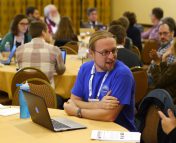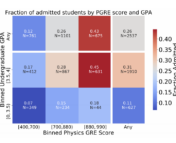This post is part of a series of cross-posts between PERbites and Astrobites about best practices in science education. As graduate students make up a significant portion of the Astrobites readership, these posts are be targeted toward them, but the practices are equally useful for any science educator.
The author of today’s article is Nick Young, a physics and computational mathematics, science, and engineering PhD student at Michigan State University and the founder of PERbites. He’s interested in applying machine learning to analyze educational datasets and understanding the graduate school admissions process for physics departments.
Title: Postsecondary physics curricula and Universal Design for Learning: Planning for diverse learners
Authors: Erin Scanlon, Jillian Schreffler, Westley James, Eleazar Vasquez, and Jacquelyn J. Chini
First author’s institution: University of Central Florida
Journal: Physical Review Physics Education Research 14 020101 (2018)
I am left handed. This means throughout elementary school I was told to just do the opposite of what the physical education and handwriting teachers did. In art class, I had to find that one pair of scissors that actually worked with my left hand (despite all the scissors supposedly being ambidextrous scissors). Then as I proceeded to high school and college, being left handed meant finding a seat in the one row of desks on the left side of the room with the left handed desks.
While I hardly consider being left-handed a disability, my experience is reflective of the way disability is handled in U.S. higher education: classes and educational spaces are designed for the “typical person” (often meaning an able bodied, neurotypical, native English-speaking person) and when someone differs from this presumed norm, the onus of accommodation falls on the individual. In this view, the accommodations are reactive. When someone who doesn’t fit the norm enters this space and requests an accommodation (a barrier in itself), then a change happens. But what if we instead tried to make those changes proactively? This is the idea behind Universal Design for Learning.
There are three guiding principles for applying Universal Design for Learning. First, any learning activity should provide content through various formats rather than a single format such as lectures or written notes. Second, students should be able to demonstrate their understanding in multiple ways (that is, not just tests). Finally, there need to be multiple pathways that the student can engage. This means that there isn’t a single set of steps through the activity as would be the case on a typical worksheet. These three principles then lead to nine guidelines and 31 checkpoints to ensure that an activity is accessible to all (table 1).

Using this framework, the authors of today’s paper wanted to see how well curriculum inspired by physics education research accommodated diverse learners. After all, students with disabilities represent approximately 20% of students in higher education. They selected four common curricula, the Open Source Tutorials in Physics Sensemaking, Physics by Inquiry, Next Generation Physical Science and Everyday Thinking, and Tutorials in Introductory Physics, and counted how many of the activities in each followed the recommendations of each of the 31 checkpoints. If at least 75% of the activities in a single curriculum were aligned with a checkpoint, that curriculum was considered aligned with the checkpoint.
Since the curricula were designed for better learning and not better access, it isn’t too surprising that most of the checkpoints were not present in the activities (figure 1). In fact, only four of the checkpoints were in most of the activities: clarifying vocabulary and symbols (2.1), highlighting patterns, critical features, big ideas, and relationships (3.2), supporting planning and strategy development (6.2) and fostering collaboration and community (8.3).

Given that so many of the activities do not meet the checkpoints of Universal Design, the authors then offered suggestions that could easily be incorporated into any class in order to make the course accessible to as many students as possible. Even teaching assistants and undergraduate learning assistants can apply many of these ideas!
(1.1) Offer ways of customizing the display of information
- This can be as simple as providing students materials digitally. For example, lecture slides can be posted before class and worksheets can be available digitally, even if the student is supposed to turn it in during class. By providing all course documents in a digital format, students can take advantage of accessibility features such as changing the zoom level or using text-to-speech. In addition, non-native English speakers can translate unfamiliar words into their native language.
(2.1) Clarify vocabulary and symbols
- Even though this checkpoint was in the majority of activities, only one of the curricula applied this checkpoint on more than 80% of the activities. Put simply, this checkpoint can be thought of as explaining an unfamiliar term before using it. For example, when introducing apparent magnitude, one way to apply this checkpoint would be to say ” when we look at the sky and see a star, how bright it appears to us is the apparent magnitude.” In this example, we’ve defined what apparent magnitude is before even saying the term. Additionally, when working on example problems, all quantities should also be matched with their symbol. For example, don’t say “the final momentum of a ball”, say “the final momentum, pf, of a ball.”
(3.1) Activate or supply background knowledge
- Identifying what is relevant to a problem can be difficult for novice students and non-native English speakers. One way to help students is to review the relevant background knowledge before doing the problem. This could be including the textbook page number of the relevant section on the activity or even a whole class discussion to highlight the relevant knowledge. For example, when teaching Newton’s 2nd Law, referencing the section of the textbook on adding and decomposing vectors signals that vectors are needed to solve the problem.
(4.1) Vary the methods for response and navigation
- In a typical classroom, the method of response is students raising their hand and the instructor calling on them. Yet, this method may be exclusionary to students with physical disabilities. Instead, consider alternative approaches. Can students use clickers to vote on an answer or could students write or draw their answer? One way to implement the latter is through whiteboarding. Teams of students write or draw their response on a white board and then after everyone has completed their board, teams take turns sharing what they decided to put on their boards. There’s even an entire article about whiteboarding best practices!
(6.4) Enhance capacity for monitoring progress
- More recent work by the authors suggest instructors should also take into account student stress and anxiety. One strategy recommended by students is to offer study guides, practice tests, and weekly quizzes so they could see how much they knew before the high-stakes exams.
(7.1) Optimize individual choice and autonomy
- Most homework and labs are heavily structured: students complete a set of tasks in a specific order at a pre-assigned level of difficulty. Instead, give students the opportunity to choose a task appropriate to them. For homework, this could mean adding a challenge problem. For labs, this could mean providing students with a goal or open-ended prompt rather than a specific research question. The College Board has an example of an open-ended projectile motion lab. Notice that there are no explicit research questions for students to answer.
(8.1) Heighten salience of goals and objectives
- At the start of class, provide an agenda for the class period and what the key learning objectives are. As students work through the activities of the class period, restate those goals and how the activities accomplish the learning objectives.
These are only a few ways to incorporate the elements of Universal Design for Learning into your class. If you would like to learn more about the checkpoints, take a look at the Universal Design for Learning Guidelines website. The website includes possible ways to apply each checkpoint as well as the research that went into each checkpoint. Through these guidelines, you can ensure that students of diverse backgrounds and abilities can participate in your course. As the authors state, who we are prepared to teach expresses who we expect to participate in physics and astronomy.
Adapted from a previous PERbites post.
Figures used under Creative Commons Attribution 4.0 International license. Featured image from the World Bank Photo Collection and used under Creative Commons BY-NC-ND-2.0.




